Veni, veni paxlovid!
Tagged:COVID
/
MathInTheNews
/
PharmaAndBiotech
/
R
/
Statistics
Today Pfizer announced they’ve submitted the final data package to the FDA for their COVID-19 anti-viral oral therapy, paxlovid. Wanna take a look at the (scant) data we have so far, as a holiday gift of sorts to all of humanity?
Paxlovid on the precipice
Ok, why is everybody so tightly wound around the axle on the subject of Pfizer’s paxlovid?
- It’s an oral drug (pills) that looked in an early analysis of part of its clinical trial like it reduced COVID-19 hospitalization by 89% if given early enough.
- That could be big news for treating both the superstitious vaccine resisters and the vaccinated who get breakthrough infections.
- It could also be utterly game-changing if the safety data is good, since it could be used prophylactically to the contacts and family of an infected person, given enough testing and tracing. (We’re still working on high-availability testing here in the US.)
But… we thought these ame thing about Merck’s molnupiravir, but the efficacy basically fell through the floor (i.e., went negative) when the data was completed, and had major safety concerns with mutagenicity and breeding new variants.
So we’re either going to get all our dreams of holiday gifts to come true here, or have the fantasy balloon of COVID-19 treatment popped painfully.
Which is it?
The paxlovid data package submitted to the FDA this morning
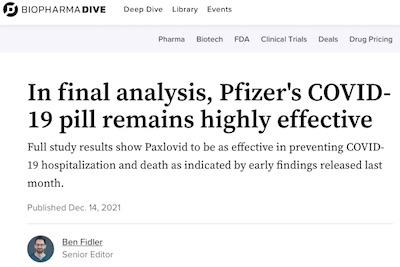 This afternoon in my email was something from BioPharma Dive. (Yeah, I was slumming.
You caught me. In my defense, LinkedIn thought this was “appropriate” for me and began
emailing it to me; being a lazy slug I haven’t bothered to figure out how to turn it off
yet.) But since I was anxious to see paxlovid move along toward approval, so people can
stop moving along toward death, my eye was caught by a title that contained the words
“Pfizer”, “COVID-19 pill”, “final analysis”, and “effective”. [1]
This afternoon in my email was something from BioPharma Dive. (Yeah, I was slumming.
You caught me. In my defense, LinkedIn thought this was “appropriate” for me and began
emailing it to me; being a lazy slug I haven’t bothered to figure out how to turn it off
yet.) But since I was anxious to see paxlovid move along toward approval, so people can
stop moving along toward death, my eye was caught by a title that contained the words
“Pfizer”, “COVID-19 pill”, “final analysis”, and “effective”. [1]
Yep, it apears the data package for paxlovid has been submitted to the FDA. In the comments at TheZvi, I had opined that if it were submitted by last Friday, then with perfect scheduling and nobody playing “Joe Manchin at the FDA”, we might get Emergency Use Authorization by the end of this year. Well, we didn’t make last Friday, but we made today, a slip of 4 days.
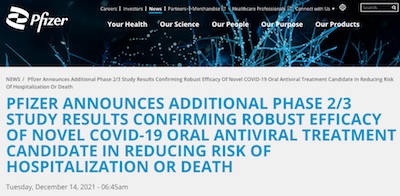 Our next stop is the primary source: the Pfizer press release from 6:45am
today [2], saying that the data package was delivered to the
FDA and one or two coy facts about the good news contained therein. Keep in mind this is
a press release, where Everything Must Be Good News. Here at Chez Weekend, we are always
and invariably deeply and darkly suspicious of press releases. When we can see the actual
data package and, more importantly, the independent FDA analysis of it, then we’ll really
know what’s what. This is preliminary!
Our next stop is the primary source: the Pfizer press release from 6:45am
today [2], saying that the data package was delivered to the
FDA and one or two coy facts about the good news contained therein. Keep in mind this is
a press release, where Everything Must Be Good News. Here at Chez Weekend, we are always
and invariably deeply and darkly suspicious of press releases. When we can see the actual
data package and, more importantly, the independent FDA analysis of it, then we’ll really
know what’s what. This is preliminary!
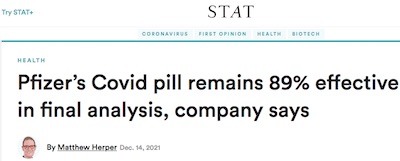 I also decided to check out STAT News, where Helen Branswell and Matthew Herper have
been keeping me sane (sort of) the last couple months. It turned out that Herper got the
gig here, and wrote a summary. [3]
I also decided to check out STAT News, where Helen Branswell and Matthew Herper have
been keeping me sane (sort of) the last couple months. It turned out that Herper got the
gig here, and wrote a summary. [3]
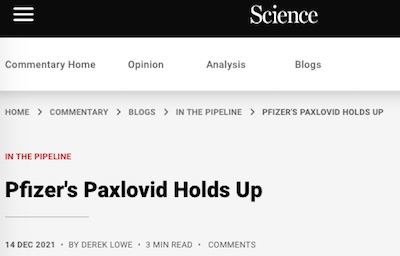 Also, the formidable med-chem blogger Derek Lowe weighed in at
In the Pipeline. [4]
Also, the formidable med-chem blogger Derek Lowe weighed in at
In the Pipeline. [4]
It really looks like we’re all reading the same press release, and coming to the same conclusions. At least we agree about what it says, even though we wish it said more (like a link to the actual data package!).
Yeah, fine. But what’s in it?
Good question.
Nobody outside Pfizer and the FDA have seen it yet. I just checked the calendar of the FDA advisory committees, and paxlovid is not there yet. Keep in mind the FDA just got the data either last night or this morning, so they’re a little busy right now and won’t surface even for a pizza until at least sometime tonight. They won’t know for some days if they have a similarly reanalyzed result that will justify an AMDAC meeting.
Also keep in mind that AstraZeneca’s evusheld was approved without an external advisory committee meeting! The FDA just said, more or less, “Looks right to us. Good job. EUA.” and that was that. They don’t always need an external committee to tell them what to do.
So that means we’re working from the Pfizer press release, and a couple news reports by reporters whose only source is that same press release. As I said, preliminary. We’ll have to wait for the FDA to emerge from its pyramid with The Official Word, but at least the clock is ticktocking on that now. I imagine anybody who works on this at the FDA is painfully aware of this.
Ok… if you must. What’s in the press release?
Here’s what I got out of the sources below:
- Efficacy: The fear we all had that this would be another molnupiravir, fizzling out
in both efficacy and safety, did not happen.
- The interim analysis said 89% efficacy against hospitalization, and the final efficacy said 88%, i.e., no statistically significant change.
- There was 89% efficacy if given within 3 days of symptoms, and 88% within 5 days, so the window of opportunity to treat is not as narrow as feared.
- Risk reduction (I think they mean the efficacy, but RR is another specific technical term, so I need the actual package to know what this means) in those over age 65 was a stunning 94%, i.e., higher in the population of high medical need.
-
The numbers and their confidence limits: 28 days after treatment, there were 5/679 patients in the treatment arm hospitalized, versus 44/682 in the control arm. That gives us a central estimate of the efficacy of: 1−(5/679)/(44/682)=88.6%. So their report is consistent.
Using the Weekend Reading R script for estimating efficacy confidence limits with a scaled binomial model [5], we get a very respectable confidence limit of 72.3% – 95.3%:
> signif(efficacyAndCL(679, 5, 682, 44), digits = 3) LCL Eff UCL 0.723 0.886 0.953Also, there were 0 deaths in the treatment arm vs 12 in the placebo arm. So before anybody tries to bust my chops about “100% efficacy vs death”, let’s get the confidence limits on that, where we see a not too wildly indecisive 68% – 100% (confidence limits on rare events are always wide, because you can’t get enough samples; since each sample is a death, rarity is a Good Thing):
> signif(efficacyAndCL(679, 0, 682, 12), digits = 3) LCL Eff UCL 0.68 1.00 1.00 -
Viral load: It reduced viral load in the treatment arm vs placebo arm by a large fold ratio: 0.93 log10 copies/ml, which in the vernacular is nearly a 10-fold reduction (100.93=8.51, so ok, maybe an 8-fold reduction).
Translation: “ginormous”. The drug is working by a mechanism of action (reduction in viral load) that is right down at the root cause of the disease. It’s extremely difficult to argue that the drug is not doing what it looks like it’s doing, namely curing COVID-19.
-
Side effects: There are always side-effects, sometimes unpleasant, sometimes even fatal. The side effects here were described as “mild”. (But remember: this is a press release, so they would say that, wouldn’t they?)
More to the point is whether side effects were so strong as to get people to drop out of the trial: 2% dropout in the treatment arm, vs 4.2% in the placebo arm. The treatment arm experienced fewer or milder side-effects (enough to make people drop out) than the placebo. Always love to see that.
-
Vaccinated vs unvaccinated: In vaccinated subjects, it was less good at reducing symptoms, but still reduced hospitalization by 70%. Now there are more vaccinated these days, so 70% of a larger number, as Zvi pointed out, might mean more than the percentage reveals, though the vaccinated are at lower risk overall.
There will be animated discussion on this, both by the FDA wondering for whom it should be described, as well as nimrods who think it means they can shirk vaccination. Though if the safety profile is good, an unrestrictive prescription profile would make sense.
-
Variants: In the trial it worked against several variants (quantitative data pending), and lab tests indicated efficacy against Omicron (inhibits the same viral protease essential to viral reproduction).
This is in vitro data, not actual combat usage against COVID-19 patients in the wild. So it could change, but at least it points in the hopeful direction. It’s possible Omicron could mutate its 3CLpro protease to escape paxlovid. But at least for now, Omicron has only 1 mutation there (P132H in ORF1ab), which is not (yet) enough.
There will likely be robust discussion at the FDA regarding the tradeoff between wide use of paxlovid vs selection pressure to mutate 3CLpro to escape paxlovid. I don’t personally know anything like enough about how to make that trade-off, and just hope that people who do know discuss it at the hearings.
Resistance to paxlovid is another incentive to try combination therapy, since it’s dramatically harder to mutate to evade simultaneously 2 drugs with different mechanisms. Maybe with molnupiravir, if that ever gets approved; maybe with fluvoxamine; maybe with monoclonal antibodies; maybe… maybe.
-
Availability: US government has bought 10 million courses of treatment for $5.3bln ($530/course of treatment, cheaper than molnupiravir?!). Pfizer claims 200,000 courses available this year, and 80 million next year. Given that there are only 17 days remaining in this year and it’s not yet approved, that’s impressive.
Though as Zvi pointed out, 200k doses might be a single day’s worth by the end of the year. Then again, if it gets approved Dec 30, that works out for the 1 remaining day of the year. Not in a good way… but it does work out.
Still, I’m betting on a narrower FDA Emergency Use Authorization. The risk of ritonavir interacting with other drugs is high (though known, so physicians have to check before prescribing), and the more widely an antiviral (or, for that matter, antibacterial) is used the more likely resistance mutations happen. So probably it’s going into the highest-risk populations first.
Using it in combination with something else with a different mechanism of action would somewhat de-risk the situation as far as paxlovid escape mutations go.
-
Dosing: Dosing would be 2 pills of nirmatrelvir and 1 of ritonavir, twice a day.
It’s a combination medication: nirmatrelvir is Pfizer’s new inhibitor of a SARS-CoV2 protease, and ritonavir helps it along. Ritonavir is also a protease inhibitor in its own right, but its main role here is to inhibit the liver mechanisms that would break down nirmatrelvir, thus making it last longer in the body.
Ritonavir is a well-known drug, used chronically by those with HIV to inhibit the HIV proteases. That’s pretty good news: we know a lot about the safety of HIV meds, and it’s moslty good. (Mostly: because ritonavir slows the breakdown of other drugs, it interacts with a lot of other medications, and therefore warrants a cautious doctor looking down your medication list. Some may need to have increased doses, others decreased doses, others temporarily substituted wit another drug.)
We can hope for reasonably free use here if we take those precautions, maybe?
The Weekend Conclusion
Ok, that’s more or less it:
- The FDA has yet to act on Merck’s molnupiravir, 2 weeks after the narrow AMDAC vote in favor of it. Britain has authorized it [6], but France rejected it. [7]
- Paxlovid is moving along. Everything looks good so far, from what little is available.
- On the other hand, what’s available is from a relatively slim press release. (I haven’t dug into clinicaltrials.gov to see if there’s an official report there yet.)
So… things could change.
US deaths from COVID-19 are just around 800,000. Now the FDA has the next move. Tick, tock… tick, tock… tick, tock…
Addendum 2021-Dec-16: Looks like the Europeans got there first… sort of
This week the European Medicines Agency (EMA) had a meeting of its Committee for Medicinal Products for Human Use (CHMP), and they advised that paxlovid can begin to be used in Europe (according to a Pfizer press release). [8] The EMA is (sort of) like the US FDA, and the CHMP is a bit like several of the FDA advisory committees (AMBAC, VRBPAC in this case).
They authorized it under European regulations which are (again, sort of) like the Emergency Use Authorization in the US, i.e., it’s not fully authorized and it’s up to the medical authorities of the member states to decide to allow it on an emergency basis. So lots of political Rube Goldberg machinery has to wheeze into action… but at least it’s action.
They advised it for patients who (a) do not yet need supplementary oxygen and (b) have other risk factors for the disease, and that it should be administered within 5 days of symptoms. So, as predicted above, they wrote for it somewhat narrowly. They hedged a bit on “adults at standard risk”, but said it was being studied.
Apparently the fact that paxlovid showed in vitro activity against Omicron was of some interest, as is completely understandable given the steep trajectory of Omicron.
Addendum 2021-Dec-21: Rumor has FDA approval this week?
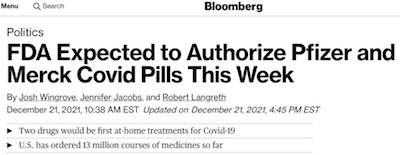 Reuters reported just this morning essentially a rumor that molnupiravir and paxlovid
will be “approved” (presumably under EUA?) this week, “according to people familiar with
the matter”. [9] Or, apparently at least “three of the
people”, who asked not to be named. It looks like Wednesday (tomorrow!) would be the
earliest this can happen.
Reuters reported just this morning essentially a rumor that molnupiravir and paxlovid
will be “approved” (presumably under EUA?) this week, “according to people familiar with
the matter”. [9] Or, apparently at least “three of the
people”, who asked not to be named. It looks like Wednesday (tomorrow!) would be the
earliest this can happen.
I hate anonymous stories like this. We can’t check anything! And there’s nothing on the FDA’s AMDAC and VRBPAC committee meeting calendars, so it would have to be an approval without the external advisory committee, like evusheld. That’s somewhat rare, but it can happen. Maybe the paxlovid data is good enough to warrant this; molnupiravir looks like a hot mess right now. A sense of urgency, I guess.
Still… maybe tomorrow will be A Good Day. In the meantime, as Reuters says:
The FDA declined to comment.
Notes & References
1: B Fidler, “In final analysis, Pfizer’s COVID-19 pill remains highly effective”, BioPharma Dive, 2021-Dec-14. ↩
2: Pfizer Media Relations, “PFIZER ANNOUNCES ADDITIONAL PHASE 2/3 STUDY RESULTS CONFIRMING ROBUST EFFICACY OF NOVEL COVID-19 ORAL ANTIVIRAL TREATMENT CANDIDATE IN REDUCING RISK OF HOSPITALIZATION OR DEATH”, Pfizer Press Releases, 2021-Dec-14 6:45am. ↩
3: M Herper, “Pfizer’s Covid pill remains 89% effective in final analysis, company says”, STAT News, 2021-Dec-14. ↩
4: D Lowe, “Pfizer’s Paxlovid Holds Up”, In the Pipeline blog at Science Translational Medicine, 2021-Dec-14. ↩
5: Weekend Editor, “R script for efficacy confidence limits by scaled binomial ratio”, Some Weekend Reading blog, 2021-Nov-12. ↩
6: M Moody, P Ryan, C Carvalho, “Merck and Ridgeback’s Molnupiravir, an Oral COVID-19 Antiviral Medicine, Receives First Authorization in the World”, Merck Press Releases, 2021-Nov-04. ↩
7: Haute Authorité de Santé, “Covid-19 : deux nouveaux traitements évalués par la HAS”, HAS Presse Communiqués, 2021-Dec-19. ↩
8: Pfizer Media Relations (Europe), “EMA Issues Advice for Potential Early Use of Pfizer’s Novel COVID-19 Oral Antiviral Candidate”, Pfizer Press Releases, 2021-Dec-16 10:30am. ↩
9: J Wingrove, J Jacobs, & R Langreth, “FDA Expected to Authorize Pfizer and Merck Covid Pills This Week”, Reuters, 2021-Dec-21. ↩

Gestae Commentaria
This doesn’t tell us much about the time frame we’re looking at, beyond minimal availability before 2022. It sounds like a gradual ramp up that will mismatch the exponential ramp up of Omicron.
If we didn’t have litigation concerns, we could maximize the likely efficacy of each dose by delegating the prescription decisions to doctors who were informed of the degree of shortage. Or they could use something like the Charlson Index, slightly modified to correlate more closely to observed morbidity in Covid patients.
Instead, we’ll probably have a cruder, less efficient triage situation.
Oh yes, absolutely.
No question: it will be tricky, especially with initial supply constraints.
Given the likelihood that ritonavir interacts with prescriptions already being taken, it will require a physician who knows drug interactions and who’s willing to take a close look at the patient before prescribing. And given the fear of resistance mutations if used too widely, I’m betting the FDA & CDC authorize it for a high-risk population only.
But I’m afraid that observing American reactions to the pandemic has turned me from an idealist to a cynic. We’ll probably just fight about it. There are already conspiracy theories claiming paxlovid is repackaged ivermectin at a higher price, so they call it “Pfizermectin”.
I honestly just don’t know what to do about stuff like that.